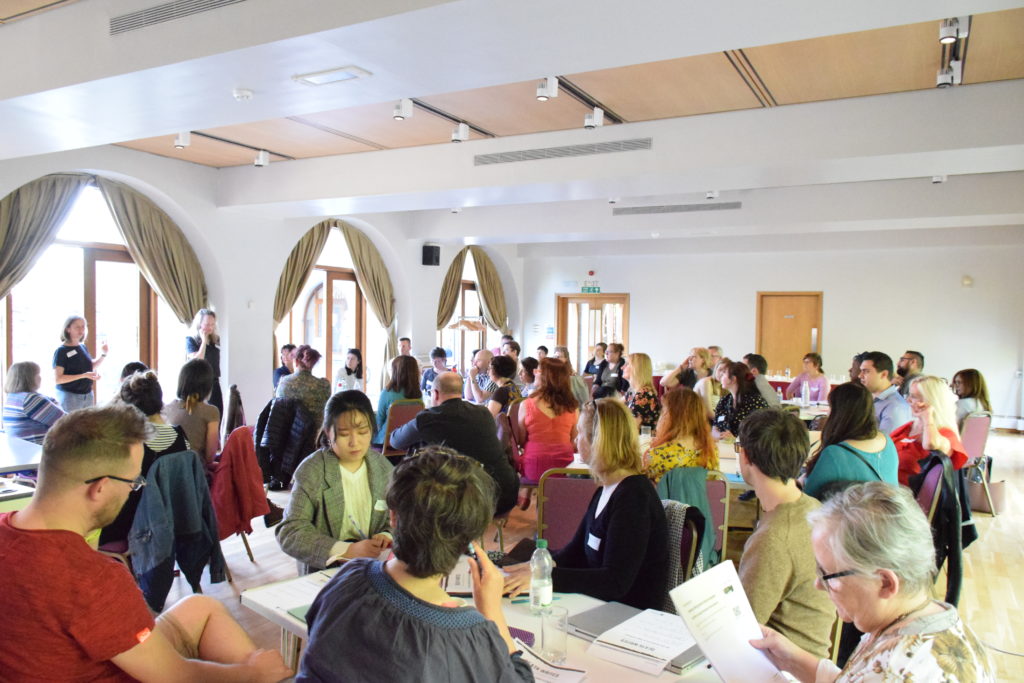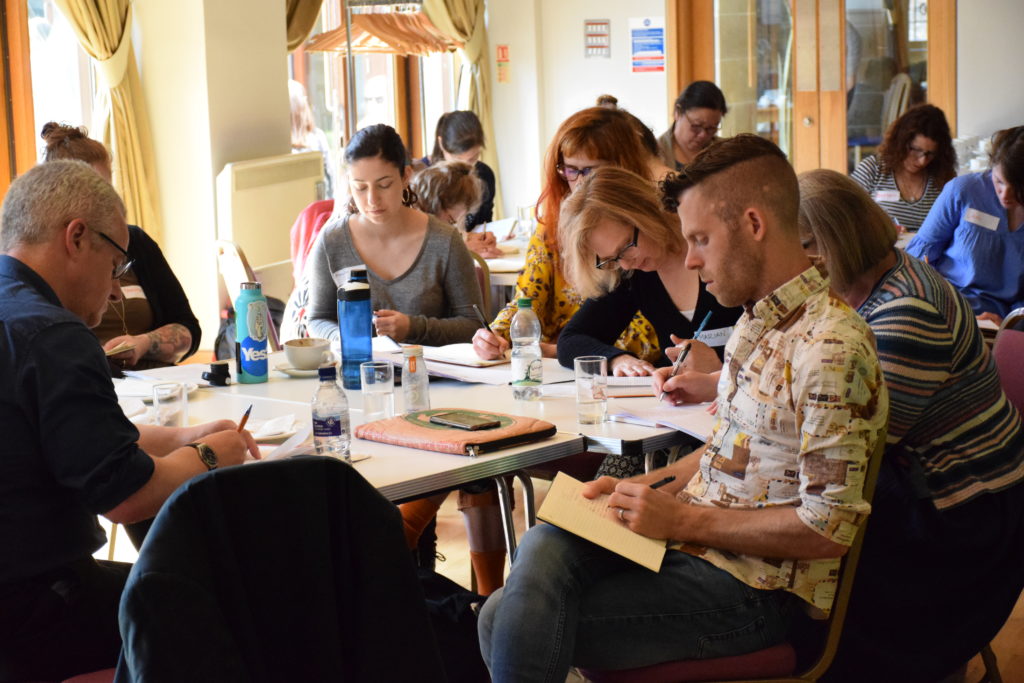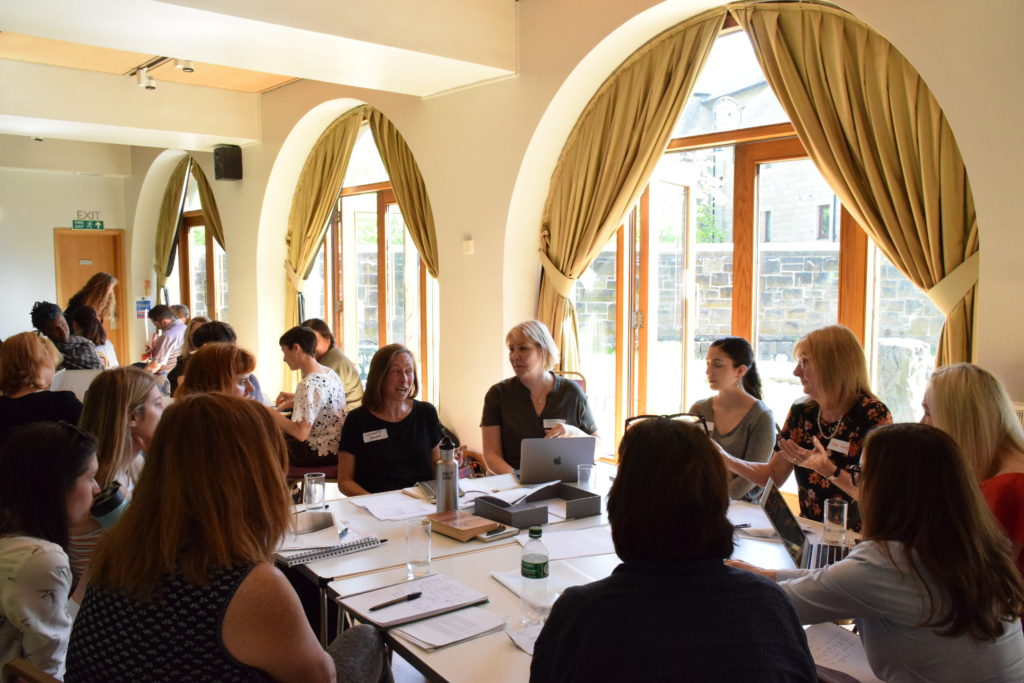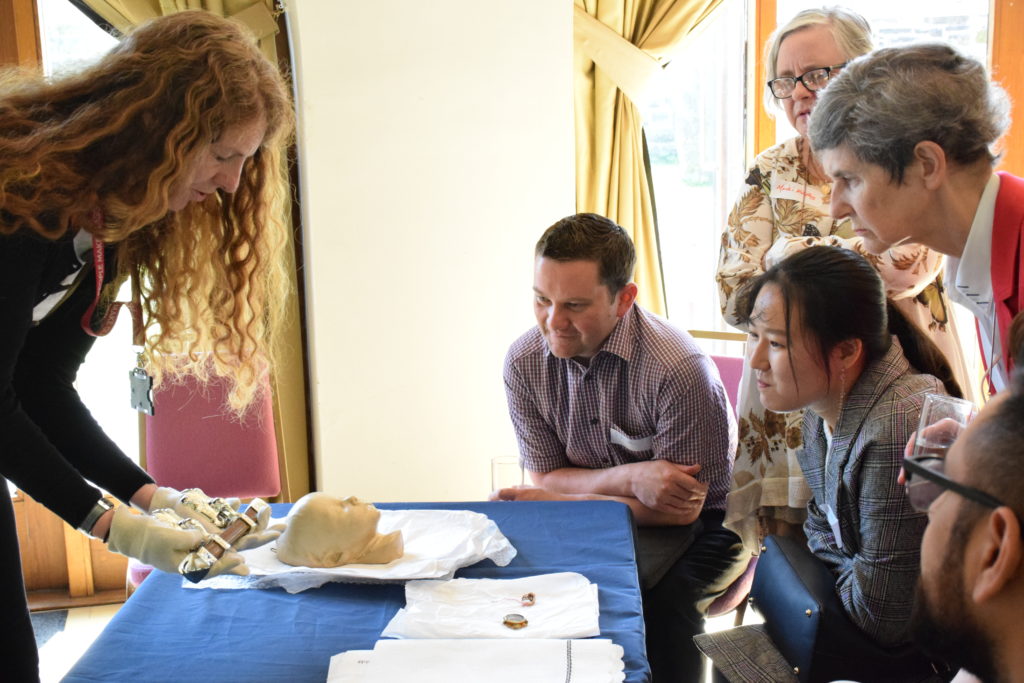Death is not monolithic. It is better to think about deaths and dyings. So said a participant about what she had learnt from our half day symposium on reading and writing death, in May 2019, held at the St Mungo Museum for Religious Life and Art in Glasgow .

Not monolithic indeed. Our plan for the day was to provide multiple points of entrance and different disciplinary perspectives on this universal topic. Creative writing, creative non-fiction, anthropology, poetry, philosophy – how does each seek to approach this topic, historically and in new boundary pushing forms? Are there any links between each discipline’s approach or are there shared representational challenges? We took a ‘facet’ approach to the day, letting our topic refract the knowledge in different directions to shine light elsewhere and in unexpected places.
Elizabeth Reeder welcomed everyone and set out the ethos and approach to the discussion and workshops. She spoke about the writing process, how we hold different questions in our work and how these help us decide register, approach and form for our writing. She read a short excerpt from her m/s of lyric essays, microbursts, and the opening to her story, ‘Attendance’ – offering two distinct explorations of living grief (via essay and fiction).
Naomi Richards reflected on anthropology’s ultimate other – death – and its disordering force. It is death that gives rise to so many cultural constructs – from religion to medicine to psychoanalysis – and it is death that prompts us to develop cultural scripts to make collective sense of our experiences. Popular books on death and dying pick up on those scripts and play with them – layering them, subverting them, rearranging them – and then feed them back into the cultures which spawned them.
Amy Shea read from her PhD writing which concentrates our attention on the indigent, homeless, disenfranchised other in American society, and how the lack of societal care experienced through life extends into dying and memorialisation practices. Death is the great equaliser but not all deaths are created equal.
After lunch we broke into 6 different workshops to engage in close reading and writing exercises.
In Naomi’s anthropology workshop, they discussed Bronislaw Malinowski’s article ‘Magic, Science and Religion’ from the 1920s, and an excerpt from Lisa Stevenson’s chapter ‘Life Beside Itself’ from 2014 about suicide in Inuit communities in the Canadian Arctic. Just some of the questions these discussions brought forth were: what authority do writers have to make general statements or impose theory on individual experiences in all their emotional complexity? How might dreams, premonitions, intuition offer a liminal (and poetic) space for exploring the relationship between the living and the dead? How can we inform readers without petrifying our knowledge and continuing to allow for uncertainty in our analysis while also saying something of consequence? As one workshop participant said “as an artist, you sit in uncertainty”. Somewhere between Malinowski and Stevenson, anthropologists have learnt to do the same.

In Amy’s workshop, they read, discussed, and wrote around the ideas of dying as a disenfranchised or marginalized person. There were discussions around different perspectives in writing on homelessness and death including an excerpt from the book Stories in the Shadows, where Dr. James O’Connell wrote about his experiences in homeless medicine, and the essay “Indigent Disposition” where Christopher Notarnicola, as one attendee noted, used the body to both show the humanity and objectifying of the homeless in life and death. The attendees debated the need for death positivity, awareness, and literacy and the language used to describe these communities, as well as how to make such communities more inclusive. They also discussed myths around homelessness, such as the idea that “some choose to live that way and so may choose to die as a pauper” and how that shouldn’t prevent societies from trying to make sure all people have agency, choice, and dignity on their terms when they die. Their discussions and writing were as varied and diverse as the workshop attendees’ perspectives were.

In Elizabeth’s workshop they discussed extracts from Anne Carson’s Nox, Max Porter’s Grief is the Thing with Feathers, and a section from Elizabeth’s microbursts that conveyed her mother’s death. All three extracts exemplified different experimental and inter-medial approaches to dying, death and grief, and the close readings drew attention to the different choices each author made as they explored the questions and observations they had. The group discussed the boundaries/ restraints/ constraints writers work within (either imposed (of discipline, for example) or choose (‘I can’t write about that – it would upset my family/friends’)) and how they impact explorations of difficult ideas and concepts. Participants wrote about the limitations or restraints they hold and then attempted writing that pushed beyond these (or utilised restraints as a pressure point for different writing).

Dr Dave Borthwick ran a workshop on poetry using poems from Yoel Hoffman’s edited collection Japanese Death Poems Written by Zen Monks and Haiku Poets on the Verge of Death, Emily Dickinson’s poem “I heard a Fly buzz” (465). Jane Kenyon’s “Reading Aloud to My Father”, Raymond Carver’s “What the Doctor Said”, A.K. Ramanujan’s “A Hindu in His Body”, Anne Stevenson’s “The Minister”, Denise Levertov’s “The Change”, Ellen Bass’s “The Thing is” and “Crow” from Max Porter’s Grief is the Thing With Feathers.
Dr Ben Colborn ran a workshop on analytical philosophy’s approach to the topic based on a reading of Bernard Williams’s chapter “The Makropulos case: reflections on the tedium of immortality”.
Elaine Addington and Janice Hamilton from the Glasgow Open Museum brought along selected objects from the Glasgow Museums Collection, such as a mourning brooch, a coffin handle and a baby’s death mask from the 1920s. Joseph Wood, a PhD student with the End of Life Studies Group, then facilitated writing exercises based on participants’ responses to the objects.

This symposium was funded jointly by the University’s ArtsLab and the Glasgow End of Life Studies Group. Feedback from the day showed that people were unanimously appreciative of being presented with a creative inter-disciplinary space to discuss death and dying with clamouring for more of the same.
We view it as being the first of many symposia, spanning different media and forms, with possibilities of:
Death writes images
Death writes food
Death writes sounds
To contact us or follow the development of this network you can find us on Twitter @deathwrites1

